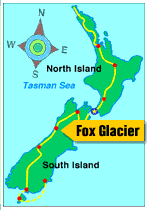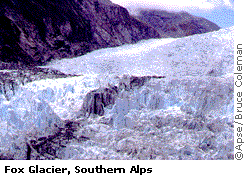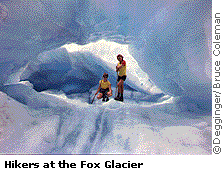 |
Fox Glacier |
 |
|
 What happens when snow falls, but the temperature never warms up enough to melt it? The snow is gradually compressed into ice, which begins to grow and grow — until a river of ice slides slowly down the mountainside from its own weight. Along the way, the sliding ice picks up hard rock, dirt, and more ice, slowly cutting through the rock and earth below. This river of ice is known as a glacier.
What happens when snow falls, but the temperature never warms up enough to melt it? The snow is gradually compressed into ice, which begins to grow and grow — until a river of ice slides slowly down the mountainside from its own weight. Along the way, the sliding ice picks up hard rock, dirt, and more ice, slowly cutting through the rock and earth below. This river of ice is known as a glacier.
On the west coast of New Zealand's South Island, ice once lay 500 meters thick above the present-day Southern Alps. Today, the Fox and Franz Josef Glaciers reach down from the high mountain valleys towards the Tasman Sea. These glaciers are constantly changing and moving — accumulating ice due to the high-altitude precipitation, but also melting rapidly because of the warmer climates below. Over thousands of years, the glaciers have carved out lakes, rivers, fjords, and broad U-shaped valleys on the mountainside. These areas trap water and soil, supporting many different types of plants and wildlife. Want to learn more about glaciers? Explore these Web sites to see a diagram of a forming glacier, find out where glaciers are located around the globe, and discover more cool facts about these moving mountains of ice! |
|||
 On his trek along the Routeburn Track and his visit to Fjordland, Colin
observed the Fox Glacier. From the Key Summit, he looked at how glaciers
have shaped the land and affected life in this part of New Zealand.
On his trek along the Routeburn Track and his visit to Fjordland, Colin
observed the Fox Glacier. From the Key Summit, he looked at how glaciers
have shaped the land and affected life in this part of New Zealand.